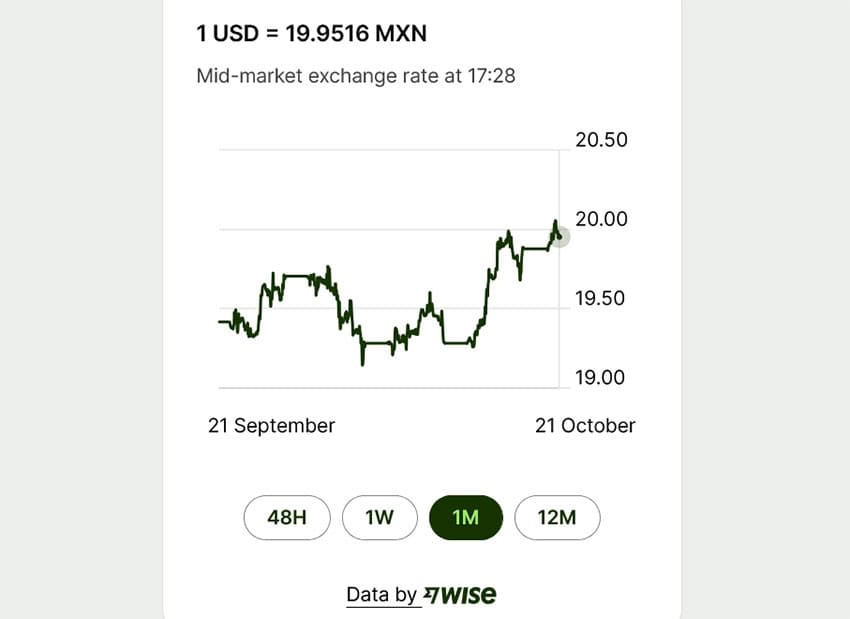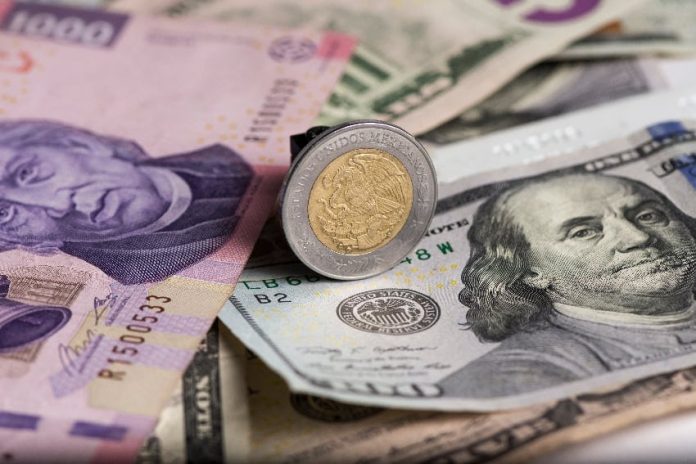The Mexican peso depreciated to above 20 to the US dollar on Monday morning before strengthening to close just below the 20-to-the-greenback mark, as the U.S. presidential election draws near.
Analysts cited what they called a growing possibility of Donald Trump winning the Nov. 5 presidential election in the United States as one reason for the weakening of the peso on Monday after it ended last week at 19.88 to the dollar.
Trump has pledged to impose hefty tariffs on cars made in Mexico and renegotiate the USMCA if he returns to the White House next January. Polls continue to show a very tight race between the Republican Party candidate and the Democratic Party’s nominee, Vice President Kamala Harris.
Peso depreciates then rallies, but ends weaker than its closing rate on Friday
According to currency exchange website xe.com, the weakest position for the peso on Monday was 20.05 to the dollar.
The Bank of Mexico’s official closing rate was 19.97 pesos to the greenback, representing a depreciation of 0.45% for Mexico’s currency compared to the USD:MXN rate at the end of trading on Friday.
Janneth Quiroz, director of analysis at the Monex financial group, said on X on Monday that the peso was “affected by a sentiment of caution from investors due to the possibility that the Fed will reduce the federal funds rate [in the United States] more slowly than anticipated,” and by “growing probabilities” that Donald Trump will win the presidential election in the U.S. and the likelihood that the Chinese economy will slow more than expected.

Alejandro Gómez, an economist and financial analyst, said that the “greater probability” that Trump will win the presidential election as well as “expected volatility moving forward” were placing pressure on the peso.
For her part, Gabriela Siller, director of economic analysis at Banco Base, said that the weakening of the peso “signals that the market expects greater volatility after the United States elections.”
On Monday, the peso was also affected by a general strengthening of the US dollar, as shown on the DXY index, which measures the greenback against a basket of major foreign currencies.
A constitutional crisis?
Currency website FX Street reported that “rising fears of a constitutional crisis in Mexico” also weighed on the peso on Monday. That was a reference to President Claudia Sheinbaum’s refusal to comply with a judge’s order to withdraw the publication of a decree that promulgated the government’s controversial judicial reform.
Some newspaper columnists and federal judge Juan Pablo Gómez Fierro are among those who claim that Mexico is already facing a constitutional crisis due to Sheinbaum’s decision to ignore the federal judge’s order.
Tony Payan, executive director of the Center for the U.S. and Mexico at Rice University’s Baker Institute for Public Policy, also asserted that Mexico is entering a “constitutional crisis.”
In support of that claim, Payan wrote on X that Sheinbaum “said she’ll willfully fall in contempt of court after a federal judge orders congressional approval of the dismantling of the judicial branch halted due to legislative procedural violations.”
#Mexico‘s entering a #constitutionalcrisis. Pres @Claudiashein said she’ll willfully fall in contempt of court after a federal judge orders congressional approval of the dismantling of the #judicialbranch halted due to legislative procedural violations-so much for the #RuleOfLaw.
— Tony Payan (@PayanTony) October 19, 2024
The judicial reform — which was promulgated by former President Andrés Manuel López Obrador in September and whose most controversial provision is that which allows Mexican citizens to directly elect all judges, including Supreme Court justices — is a major factor in the significant decline of the peso since Mexico’s June 2 elections.
The peso was trading at around 17 to the dollar before Sheinbaum and the ruling Morena party won comprehensive election victories, putting Morena and its allies in a strong position to approve a range of constitutional reform proposals.
Several constitutional bills, including the judicial reform and a reform that placed the National Guard under the control of the military, have passed Congress since recently-elected lawmakers assumed their positions on Sept. 1.
With reports from El Economista and FX Street
